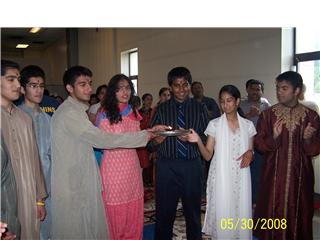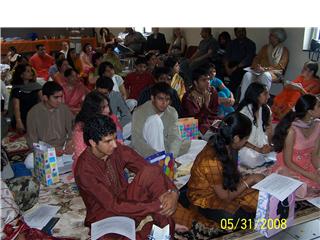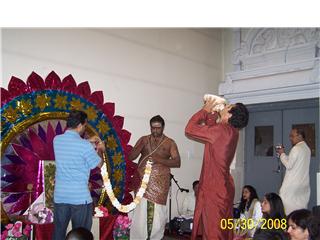Contribute
| Vedic Graduation Ceremony 2008 At Sri Lakshmi Temple |
Press Release
06/11/2008
A historic first for any temple in the United States, the very first Vedic graduation was held at Sri Lakshmi Temple, Ashland, on May 31, 2008 in association with the Bal Vihars of Vishwa Hindu Parishad. The graduating students were recognized for their several years of participation in community service and for their active participation and interest in knowing their roots of Hindu Dharma. The Vedic graduation corresponded with high school graduation for the twelve seniors who start college in fall.
The formal ceremony began with Ekta mantra sung by the emcees Ashwini Javlekar and Sadhna Gupta. This was followed by Sri Ganesha vandana and Ma Saraswati vandana sung to perfection accompanied on a harmonium by Karuna, Rishi, and Mohanji. The spiritually uplifting strains of the vandanas brought an air of solemnity to the ceremony where all sat on the carpeted floor traditional to such graduation with minds collected for the occasion. The president of Sri Lakshmi Temple, Dr. Kumar Nochur formally welcomed all the students and their parents to this historic event. He reminded the students that even though they proceed to college in fall for higher studies, there is yet another type of even higher study that exists. The study of the material world (apara vidya) is good but the spiritual study (para vidya); the study of the Atman or Self is even superior.
Two senior temple pujaris, Vedamurthi Krishna Bhattar and Pandit Bairava Sundaram conducted a formal pooja for all the seniors in which the students participated by repeating the vedic mantras after the pujaris. The formal traditional strains of the mantras filled the Temple hall to further plant this Vedic samskar in the minds of the students. The students were given a package that included a certificate, and most importantly a copy of the Srimad Bhagavad Gita. Dr. Nochur while giving the awards reminded the students to read the Gita when they could, especially in time of need when away from home.
Traditionally, in ancient times, the Guru at the conclusion of formal studies in the Gurukulum sent the students home with a set of invaluable instructions. These instructions or commandment were called shikshavalli, being a distillation of age old wisdom in the form of easy to memorize summary. The same commandments were distributed to the graduating students and they were asked to ponder on the importance of the graduation ceremony, the shikshavalli, and relevance to their life in college in a message given by Dr. Mona Khaitan.
The graduation ceremony is a samskar performed for the benefit of the graduating students. The purpose of all samskars is to plant a valued seed impression in the fertile soil of the mind, thereby installing a concept or value in place. Upon cultivation, this seed takes root and grows into a large tree further producing similar seeds that become firmly embedded in the mind. The collective impressions are called good habits. Normally we associate habits with poor habits; however, habits can be either good or bad. If we did not form a habit, we would need to learn to walk every morning. It is due to formation of habits that we can perform everyday tasks. The collective tendencies in an individual form the nature of the person. When the useful habits of the 21 commandments become a part of our nature then we no longer need to consult the shikshavalli. At that time, we are living in accordance with dharma, which is spiritual and error free living.
Next, the graduating students were asked to ponder if leading a dharmic life was even relevant or useful in college. How do we relate dharmic life to our every day life and activities?
In essence, dharmic living is spiritual living. Spiritual living helps us fulfill all our goals in life. Simply, it is to live in such a way that the mind remains undisturbed and unruffled while engaged in action. Observe a lake and a tree near a lake. If the surface of the lake has ripples and is further disturbed by throwing a stone, then the tree does not reflect properly in the lake and appears fuzzy. Similarly, when we fail to follow the wisdom of the 21 commandments then we are throwing stones in the lake of the mind which disturbs the mind. A disturbed mind fails to reflect the Light of the Atman. The mind needs this Light to function properly. As a result, the mind fails to think clearly. A clouded ruffled mind takes longer to process information, makes poor choices, and becomes aggravated easily. The more the mind becomes aggravated the more it becomes disturbed, forming a downward spiral. On the other hand, a clear mind works quickly and decisively. As a result, we grasp concepts readily in college, our work is efficient, leaving us time to cultivate friendships, fulfill our obligations to our family, pursue other interests, and lead a stress free life. It makes for a healthy, happy, and fulfilling college experience. Of course, the purpose of these commandments is not limited to having a good college experience or a stress free working and family life after college. The eventual goal of human birth is to become liberated from the cycle of rebirths. So these simple instructions are useful in meeting all our goals in life, whether small or lofty. This is why at the end of the shikshavalli, it repeats, this is the ultimate instruction, this is the final guidance, this is a secret instruction, meaning it is invaluable and should be cherished and employed by us.
The students were asked to note that the shikshavalli gives importance to all teachers in our life. Our most important teacher is our mother who not only gives us birth but nurtures us throughout life. Swami Ranganathananda has said, “Hindu philosophy teaches humanity not to contract but to expand the mother sentiment. The moment we visualize God as mother, that mother sentiment goes on percolating into various aspects of human life. It is that expansion of love that is capable of uniting human beings to human beings and human beings to Nature. One needs, and uses, one’s mother for one’s own development, but one does not exploit her. So also is Prakrti, Nature, our mother, to be used wisely for our development, but not to be exploited.†The Divine Mother takes many forms. We know her in the form of Sri Lakshmi, the embodiment of all material welfare and success, Ma Saraswati, the serene Goddess of vidya, all knowledge—secular as well as spiritual, Ma Durga, who combats all evil tendencies in us, and Ma Kali, who protects us from all evil. The Devi Mahatmayam therefore sings “O Devi, all types of knowledge are Thine own diverse forms; all women also in the world are Thy diverse manifestations.†Our mother in essence represents the Divine Mother who is always with us and guides us. The students were asked to take a moment, find their mother and bow down to her and appreciate all that she has done for them and will continue to do to support them. As Adi Sankaracarya in his famous prayer said, there can be a wicked child but there can be no wicked mother.
The ceremony ended with a formal prayer followed by Prasad blessed by Sri Lakshmi in the serene atmosphere of the Sri Lakshmi Temple.
You may also access this article through our web-site http://www.lokvani.com/


